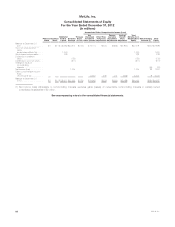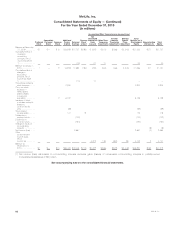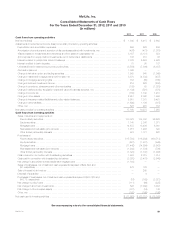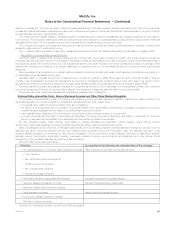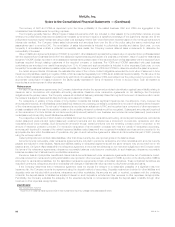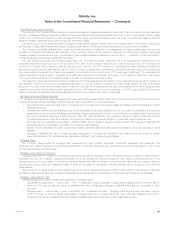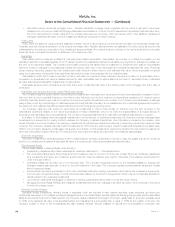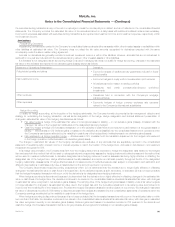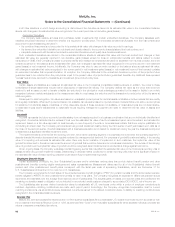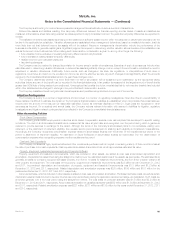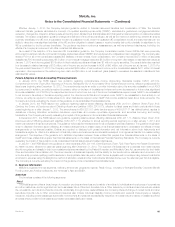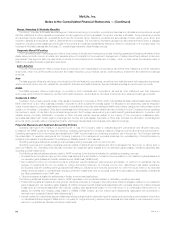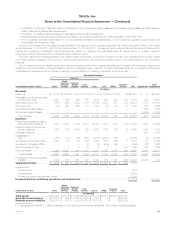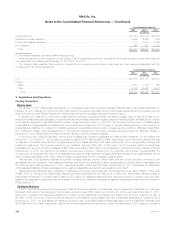MetLife 2012 Annual Report Download - page 96
Download and view the complete annual report
Please find page 96 of the 2012 MetLife annual report below. You can navigate through the pages in the report by either clicking on the pages listed below, or by using the keyword search tool below to find specific information within the annual report.
MetLife, Inc.
Notes to the Consolidated Financial Statements — (Continued)
‰Securitized reverse residential mortgage loans. Reverse residential mortgage loans originated with the intent to sell which have been
transferred into Government National Mortgage Association securitizations, for which the FVO was elected, are stated at estimated fair value.
The FVO was elected for certain loans and the corresponding secured borrowing, which is included within other liabilities. Subsequent
changes in estimated fair value of both the asset and liability are recognized in other revenues.
Policy Loans
Policy loans are stated at unpaid principal balances. Interest income on such loans is recorded as earned using the contractual interest rate.
Generally, accrued interest is capitalized on the policy’s anniversary date. Valuation allowances are not established for policy loans, as they are fully
collateralized by the cash surrender value of the underlying insurance policies. Any unpaid principal or interest on the loan is deducted from the cash
surrender value or the death benefit prior to settlement of the insurance policy.
Real Estate
Real estate held-for-investment is stated at cost less accumulated depreciation. Depreciation is provided on a straight-line basis over the
estimated useful life of the asset (typically 20 to 55 years). Rental income associated with such real estate is recognized on a straight-line basis over
the term of the respective leases. The Company periodically reviews its real estate held-for-investment for impairment and tests for recoverability
whenever events or changes in circumstances indicate the carrying value may not be recoverable and exceeds its estimated fair value. Properties
whose carrying values are greater than their undiscounted cash flows are written down to their estimated fair value, which is generally computed
using the present value of expected future cash flows discounted at a rate commensurate with the underlying risks.
Real estate for which the Company commits to a plan to sell within one year and actively markets in its current condition for a reasonable price in
comparison to its estimated fair value is classified as held for sale. Real estate held-for-sale is stated at the lower of depreciated cost or estimated
fair value less expected disposition costs and is not depreciated.
Real estate acquired upon foreclosure is recorded at the lower of estimated fair value or the carrying value of the mortgage loan at the date of
foreclosure.
Real Estate Joint Ventures and Other Limited Partnership Interests
The Company uses the equity method of accounting for investments in real estate joint ventures and other limited partnership interests in which it
has more than a minor ownership interest or more than a minor influence over the joint venture’s or partnership’s operations, but does not have a
controlling financial interest. Equity method investment income is recognized as earned by the investee. The Company records its share of earnings
using a three-month lag methodology for instances where the timely financial information is not available and the contractual agreements provide for
the delivery of the investees’ financial information after the end of the Company’s reporting period.
The Company uses the cost method of accounting for investments in which it has virtually no influence over the joint venture’s or the
partnership’s operations. Based on the nature and structure of these investments, they do not meet the characteristics of an equity security in
accordance with applicable accounting standards. The Company recognizes distributions on cost method investments as earned or received.
In addition to the investees performing regular evaluations for the impairment of underlying investments, the Company routinely evaluates these
investments for impairments. For equity method investees, the Company considers financial and other information provided by the investee, other
known information and inherent risks in the underlying investments, as well as future capital commitments, in determining whether an impairment has
occurred. The Company considers its cost method investments for OTTI when the carrying value of such investments exceeds the net asset value
(“NAV”). The Company takes into consideration the severity and duration of this excess when determining whether the cost method investment is
other-than-temporarily impaired. When an OTTI has occurred, the impairment loss is recorded within net investment gains (losses).
Short-term Investments
Short-term investments include securities and other investments with remaining maturities of one year or less, but greater than three months, at
the time of purchase and are stated at estimated fair value or amortized cost, which approximates estimated fair value.
Other Invested Assets
Other invested assets consist principally of the following:
‰Freestanding derivatives with positive estimated fair values are described in “— Derivatives” below.
‰Tax credit partnerships derive their primary source of investment return in the form of income tax credits. Where tax credits are guaranteed
by a creditworthy third party, the investment is accounted for under the effective yield method. Otherwise, the investment is accounted for
under the equity method.
‰Leveraged leases are recorded net of non-recourse debt. The Company recognizes income on the leveraged leases by applying the
leveraged lease’s estimated rate of return to the net investment in the lease. The Company regularly reviews residual values and impairs
them to expected values.
‰Funds withheld represent a receivable for amounts contractually withheld by ceding companies in accordance with reinsurance agreements.
The Company recognizes interest on funds withheld at rates defined by the terms of the agreement which may be contractually specified or
directly related to the underlying investments.
‰Joint venture investments that engage in insurance underwriting activities are accounted for under the equity method.
‰Mortgage Servicing Rights (“MSRs”) are measured at estimated fair value with changes in fair value reported in other revenues in the period
in which the change occurs.
Securities Lending Program
Securities lending transactions, whereby blocks of securities, which are included in fixed maturity securities, equity securities, and short-term
investments, are loaned to third parties, primarily brokerage firms and commercial banks, and are treated as financing arrangements and the associated
liability is recorded at the amount of cash received. The Company obtains collateral at the inception of the loan, usually cash, in an amount generally equal
to 102% of the estimated fair value of the securities loaned, and maintains it at a level greater than or equal to 100% for the duration of the loan. The
Company is liable to return to the counterparties the cash collateral received. Security collateral on deposit from counterparties in connection with
90 MetLife, Inc.


